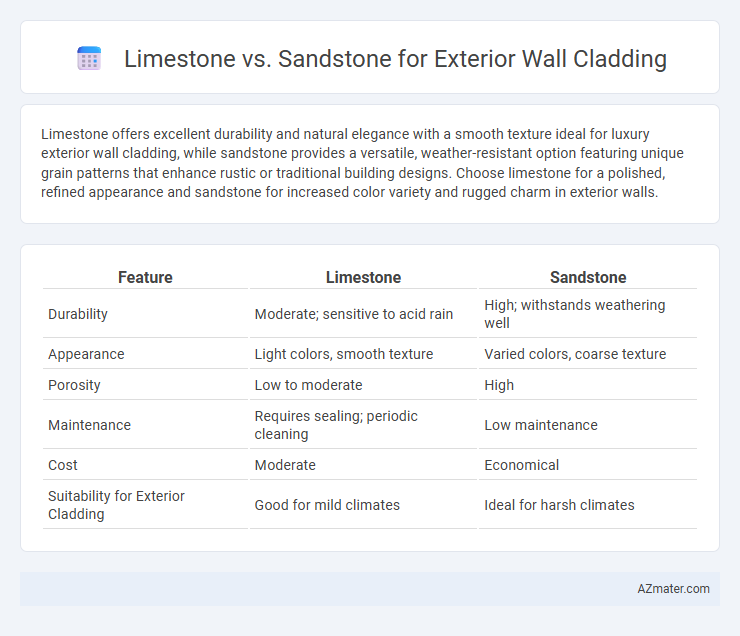Limestone offers excellent durability and natural elegance with a smooth texture ideal for luxury exterior wall cladding, while sandstone provides a versatile, weather-resistant option featuring unique grain patterns that enhance rustic or traditional building designs. Choose limestone for a polished, refined appearance and sandstone for increased color variety and rugged charm in exterior walls.
Table of Comparison
| Feature | Limestone | Sandstone |
|---|---|---|
| Durability | Moderate; sensitive to acid rain | High; withstands weathering well |
| Appearance | Light colors, smooth texture | Varied colors, coarse texture |
| Porosity | Low to moderate | High |
| Maintenance | Requires sealing; periodic cleaning | Low maintenance |
| Cost | Moderate | Economical |
| Suitability for Exterior Cladding | Good for mild climates | Ideal for harsh climates |
Overview of Limestone and Sandstone
Limestone is a sedimentary rock primarily composed of calcium carbonate, valued for its durability and natural light color variations, making it a popular choice for exterior wall cladding in historic and contemporary architecture. Sandstone consists mainly of sand-sized mineral particles or rock fragments, known for its strength, weather resistance, and warm, earthy tones that enhance facade aesthetics. Both stones offer distinct textures and color palettes, with limestone providing a smoother, more polished appearance and sandstone delivering a rugged, textured finish suitable for diverse architectural styles.
Key Differences in Appearance
Limestone typically features a smooth, fine-grained texture with muted earth tones ranging from creamy whites to soft grays, offering a classic and uniform appearance for exterior wall cladding. Sandstone presents a coarser, layered texture with a wider color palette including reds, yellows, and browns, providing a rustic and varied visual effect. These contrasting aesthetic qualities influence architectural style choices and the overall ambiance of exterior facades.
Durability and Weather Resistance
Limestone and sandstone both offer unique advantages for exterior wall cladding, with limestone being highly durable due to its dense calcite composition that resists weathering and erosion. Sandstone, composed mainly of quartz grains cemented by silica or calcium carbonate, provides excellent weather resistance but may require more maintenance to prevent surface deterioration in harsh climates. The choice between these stones depends on local weather conditions, with limestone favored in wetter environments for its robustness and sandstone preferred in drier regions for its natural breathability.
Maintenance and Cleaning Requirements
Limestone exterior wall cladding requires careful maintenance to prevent staining and erosion caused by acid rain and pollutants, often necessitating gentle pressure washing and periodic sealing to preserve its appearance. Sandstone is more porous and may accumulate dirt and biological growth more easily, demanding regular cleaning with mild detergents and sometimes biocides to maintain its aesthetic without damaging the stone. Both materials benefit from routine inspections to address mortar joint integrity and prevent moisture infiltration that could compromise wall durability.
Cost Comparison
Limestone typically costs between $6 and $12 per square foot, making it a mid-range option for exterior wall cladding, while sandstone ranges from $8 to $15 per square foot, often reflecting its higher durability and aesthetic variety. Installation expenses for limestone are generally lower due to its uniform texture and easier handling, whereas sandstone can require more labor-intensive cutting and finishing, increasing overall project costs. Long-term maintenance for limestone may incur additional expenses due to its susceptibility to weathering, whereas sandstone's natural hardness can reduce upkeep costs, affecting the total cost of ownership over time.
Installation Techniques
Limestone for exterior wall cladding requires precise cutting and anchoring due to its denser composition, often necessitating mechanical fixing systems like stainless steel anchors to ensure durability and stability. Sandstone, being softer and more porous, is typically installed using adhesive mortars and occasionally mechanical supports to accommodate its natural variations and prevent cracking. Both materials demand skilled labor familiar with their unique textures and weight distribution to achieve a secure and aesthetically pleasing facade.
Thermal Performance and Insulation
Limestone offers superior thermal mass, stabilizing indoor temperatures by absorbing and slowly releasing heat, which enhances energy efficiency in exterior wall cladding. Sandstone, while providing moderate insulation, typically has a higher porosity that can lead to increased thermal conductivity and less effective temperature regulation. Selecting limestone over sandstone can contribute to better thermal performance and improved insulation properties in building facades.
Environmental Impact and Sustainability
Limestone and sandstone both offer sustainable options for exterior wall cladding due to their natural composition and durability, reducing the need for frequent replacements and minimizing resource consumption. Limestone typically has a lower embodied energy in extraction and processing compared to sandstone, making it a more environmentally friendly choice in many regions. Sandstone's porosity enhances thermal insulation properties, contributing to energy efficiency in buildings and reducing heating and cooling demands.
Popular Design Applications
Limestone and sandstone both offer unique aesthetic qualities for exterior wall cladding, with limestone prized for its smooth texture and light, creamy tones that complement classical and modern architectural styles. Sandstone features a natural grainy texture and a wider color palette, ranging from reds to browns, making it popular in rustic and southwestern design applications. Both materials provide durability and weather resistance, but the choice often depends on the desired visual impact and regional availability in construction projects.
Choosing the Right Stone for Your Project
Selecting the right stone for exterior wall cladding depends on factors such as durability, aesthetic appeal, and maintenance requirements. Limestone offers a classic, smooth texture with excellent weather resistance but may require sealing to prevent erosion, while sandstone provides a more rugged, granular surface that withstands harsh climates with minimal upkeep. Evaluating the climate of your project location, desired architectural style, and long-term maintenance plan will guide the best choice between limestone and sandstone.

Infographic: Limestone vs Sandstone for Exterior Wall Cladding
 azmater.com
azmater.com